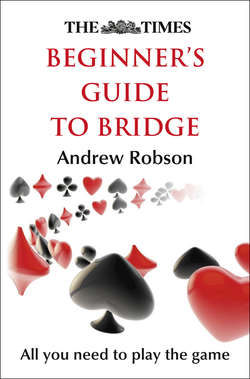Читать книгу The Times Beginner’s Guide to Bridge - Andrew Robson - Страница 37
When to go for game
ОглавлениеBidding with your partner involves first trying to find a fit, then seeing whether you have enough points between you for game. This decision process is shown here:
Now let’s look at some sample pairs of hands (we’ll assume silence from the opponents). Note that ‘responder’ is bridge jargon for the opener’s partner.
(a) Opener bids 1♠, so responder knows they have at least eight spades between them – a fit. Responder must now bid. There’s no point bidding clubs – it would only confuse matters when it’s obvious spades should be trumps. The only unresolved issue is how high to bid in spades, specifically whether or not to bid for game (4♠). Responder knows that opener has 12+ points (the minimum required in order to open the bidding), and responder has 13, thus the partnership has at least 25 points, which means that responder can go for game: she bids 4♠, a ‘jump’ from the previous bid 1♠. The bidding sequence is as follows, the underlined bid being the final contract:
(b) Opener bids 1♠. Again responder knows there’s a spade fit (opener must have four+ spades, and responder has four spades, so the partnership has eight+ spades). However responder has a relatively low point count, so should raise to 2♠. This conveys to opener that responder supports spades as trumps but her hand is only worth a minimum bid. With nothing to add to his opening bid, opener then passes. They’ve found their fit but lack the strength for game. The bidding sequence is:
(c) Opener bids 1♠, which doesn’t reveal a fit to responder. She therefore tries her favourite (longest) suit at the lowest level possible, bidding 2♣. This suit doesn’t appeal to opener, but rather than repeat spades he offers a third choice of trump suit, hearts. Responder now knows they’ve found their fit (the partnership has at least eight hearts). She considers whether the values for game are present: she has 13 points, and her partner has advertised 12+ by opening, which is enough to bid a game contract (25 points are needed to go for game). Responder jumps to 4♥. The bidding sequence is:
must know
Don’t bid unnecessarily high when bidding a new suit. Try to find a fit as ‘cheaply’ as possible i.e. the bid you reach first as you work up the bidding ladder on p. 22 (the bid that requires the least number of tricks to make a contract). Then assess whether or not you have enough points to go for game.
